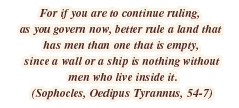|
Athenians of the Classical
period mainly thought of their city
as the sum of its citizens, not as a geographical area:
for that there were separate terms: asty (town)
to refer to Athens, or chora (country)
to refer to the remainder of Attica.
At its peak, the population of Attica was somewhere
in the region of 300,000 to 350,000. The distinction between one
inhabitant of Athens and another rested on whether he had the ability
to exercise civic rights. Pericles' citizenship law of 451 B.C. meant
that any adult male whose parents originated from an Athenian deme
qualified for citizenship. But the citizens can never have numbered more than
50,000 at most as the bulk of the population -women, metics and slaves- had no civic
rights. There was also a secondary distinction, based on
origin: men, women and children of Athenian origin were known as astoi
(townspeople). |




